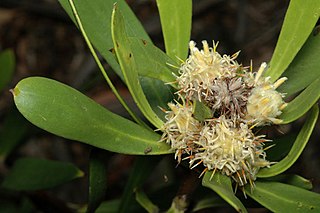
The slender glass lizard is a legless lizard in the family Anguidae. The species is endemic to the United States. Two subspecies are recognized. The lizard was originally believed to be a subspecies of the eastern glass lizard. Their name comes from their easily broken tail which they can break off themselves without ever being touched. It is difficult to find a specimen with an undamaged tail. The lizard eats a variety of insects and small animals, including smaller lizards. Snakes and other animals are known to prey on the species. Humans have a part in destroying their environment and killing their food supply with insecticides. The lizard is considered to be a least-concern species according to the International Union for Conservation of Nature (IUCN), though it is vulnerable in Iowa and endangered in Wisconsin.

Plumeria is a genus of flowering plants in the family Apocynaceae. Most species are deciduous shrubs or small trees. The species variously are endemic to Mexico, Central America and the Caribbean, and as far south as Brazil and north as Florida, but are grown as cosmopolitan ornamentals in warm regions. Common names for plants in the genus vary widely according to region, variety, and whim, but frangipani or variations on that theme are the most common. Plumeria is also used as a common name, especially in horticultural circles.

The California slender salamander is a lungless salamander that is found primarily in coastal mountain areas of Northern California, United States as well as in a limited part of the western foothills of the Sierra Nevada, California, in patches of the northern Central Valley of California, and in extreme southwestern Oregon. What makes this amphibian notable is that this species resides primarily in a limited range within California as one of a handful quasi-endemic amphibians in the state.
Hobbseus attenuatus, the Pearl riverlet crayfish, is a species of crayfish in the family Cambaridae. It is found in North America.

Psorothamnus is a genus of plants in the legume family. These are shrubs and small trees. Many are known by the general common name indigo bush. Some are referred to as daleas, as this genus was once included in genus Dalea. These are generally thorny, thickly branched, strongly scented bushes. Most species bear lupinlike raceme inflorescences of bright purple legume flowers and gland-rich pods. Psorothamnus species are native to the southwestern United States and northern Mexico. The genus is paraphyletic and it has been proposed that the genus Psorodendron be reinstated to accommodate sections Xylodalea, Capnodendron, and Winnemucca.

Conus attenuatus, common name the thin cone, is a species of sea snail, a marine gastropod mollusk in the family Conidae, the cone snails and their allies.

Isopogon attenuatus is a species of plant in the family Proteaceae and is endemic to the south-west of Western Australia. It is a shrub with oblong to spatula-shaped or linear leaves and spherical heads of yellow flowers.

Capnobotes fuliginosus is a species of katydid known as the sooty longwing. It is found in the western United States and Mexico. It is omnivorous and it is the prey of the wasp Palmodes praestans.
Capnobotes unodontus, the one-tooth longwing, is a species of shield-backed katydid in the family Tettigoniidae. It is found in North America.

Capnobotes is a North-American genus of shield-backed katydids in the family Tettigoniidae. There are about 9 described species in Capnobotes.
Conocephalus attenuatus, the long-tailed meadow katydid or lance-tailed meadow katydid, is a species of meadow katydid in the family Tettigoniidae. It is found in North America.
Paromius is a genus of dirt-colored seed bugs in the family Rhyparochromidae. There are about 15 described species in Paromius.
Capnobotes spatulatus, the spatulate longwing, is a species of shield-backed katydid in the family Tettigoniidae. It is found in North America.

Hylastes is a genus of crenulate bark beetles in the family Curculionidae. There are more than 90 described species in Hylastes.
Capnobotes occidentalis, the western longwing, is a species of shield-backed katydid in the family Tettigoniidae. It is found in North America.
Capnobotes bruneri, the Bruner longwing, is a species of shield-backed katydid in the family Tettigoniidae. It is found in North America.
Melanoplus attenuatus, known generally as the slender-bodied short-wing grasshopper or slender-bodied locust, is a species of spur-throated grasshopper in the family Acrididae. It is found in North America.
Capnobotes granti, the Grant longwing, is a species of shield-backed katydid in the family Tettigoniidae. It is found in North America.
Capnobotes arizonensis, the Arizona longwing, is a species of shield-backed katydid in the family Tettigoniidae. It is found in North America.
Lophoscutus is a genus of ambush bugs in the family Reduviidae. There are more than 60 described species in Lophoscutus.







